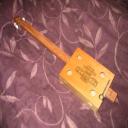Yahoo Answers is shutting down on May 4th, 2021 (Eastern Time) and beginning April 20th, 2021 (Eastern Time) the Yahoo Answers website will be in read-only mode. There will be no changes to other Yahoo properties or services, or your Yahoo account. You can find more information about the Yahoo Answers shutdown and how to download your data on this help page.
Trending News
Tucking your chin during forms/sparring.?
So during the 2 videos of me I've posted on here in questions, almost everyone said I should not be tucking my chin because it 'shows a lack of confidence'. I agree with this. However, I was doing it intentionally (and possibly a little too far, now that I watch the videos more carefully) because I was taught to do this 1: Because it makes your face a smaller target and your opponent is more likely to hit your forehead 2: It leaves your jaw much less exposed to sideways blocks such as haymakers, hooks, and roundhouse kicks, and also upwards snap kicks/uppercuts 3: Tucking the chin protects the Trachea.
However, what I am worried about is what someone said, that tucking your head renders you off balance. So my question is what do you think about this?
Sideways strikes*
12 Answers
- 7 years ago
I doubt anyone that tells you to not tuck your chin has fought full contact or done any real amount of contact sparring or had much in the way of street altercations. It should not throw your balance off really and the benefits far outweigh any reasons that you mention here not to. Jas Key there is giving you some good advice and has the right idea about this.
- YmirLv 67 years ago
You're supposed to use your arms, legs, and distance control to defend against that.
In boxing matches, they can't avoid getting hit near the face all the time, so they tuck it in so they can trade punches.
Are you doing boxing? Because if you're doing boxing, you might as well attend a boxing gym and using the traditional boxing methods.
If it is absolutely necessary to lower the chin, it is done by keeping the head level, pulled back to the spine, and then lowering one's center of mass so the chin covers the throat. Shaolin chi gong exercises used on the throat also strengthens it against impacts. There are better ways of conditioning that area than activating neck muscles that don't need activating.
Tucking the chin doesn't affect the balance directly, it affects your muscle skeleton system. Certain muscles in the arms become weakened when you activate muscles that pull your chin down, and that includes merely activating the neck muscles but not moving your chin. Your arm becomes weakened, you won't be able to project explosive power even if you could do it normally. If you hit air, the force feedback from fajin would wreck your shoulder and neck muscles in short order. Chin tuck is very defensive, or very sparring like, where getting hit a few times isn't dangerous but getting KOed is a game changer.
In martial arts, on the battlefield, the moment someone touches you, they can destroy your body. Thus the priority was to control the range, and use power for attack/defense at the same time, while handling the pressure and power of the opponent.
With the chin tucked, grappling moves will more easily unbalance you. Your frontal defense and offense will lack in power. This is a boxing technique because boxers have big gloves, they can't and aren't allowed to grapple, and the gloves alone are big enough to block hits from far.
If you want to learn how to use the chin tuck in sparring, traditional boxing techniques and training methods are far superior than doing an air hit kata about upper cuts and punching people with the chin tucked. The kata system isn't really designed for that.
In your kata video, I don't think your problem was chin being tucked in. I think your problem was your shoulders lifting up due to the way your fist moves in a spiral. When the fist is aligned such that thumb is on the bottom, your shoulder naturally lifts up out of place, you lose all the power except in your triceps and forearm, and your elbow comes out at a 90 degree angle (destroying your balance and internal structure rooted to your hips).
The spiral technique in boxing isn't designed to hit people. It's designed to drive power through once a hit has been made. Normally you would never throw out your shoulders and elbow like that, when trying to make a hit, not even in boxing.
- callsignfuzzyLv 77 years ago
Tucking your chin makes you less susceptible to being knocked out, period.
If you're leaning forward instead of tucking, you can be put off-balance. Generally, your back should be straight.
I would also suggest rolling your shoulders forward to "hide" your chin behind it.
Haven't seen the videos you're talking about, though.
- MarkLv 77 years ago
If you watch a lot of UFC fights... You'll see that a very common knockout is one fellow standing there with his chin out proudly..... Something a young boxer with a couple of lessons under his belt would never do.
There's a good reason for tucking your chin... boxers know it well.
Why on earth would you care how you looked?
- How do you think about the answers? You can sign in to vote the answer.
- possumLv 77 years ago
You weren't tucking your chin they way a boxer would, which is supposed to be the shoulder protecting the head, so it is a bit misleading to say that tucking the chin protects the fighter.
In your forms, you were doing self-defense - not sport fighting. In this position, you tucking your chin gives several impressions, namely, of lack of confidence. Find someone who does forms well, and ask them to do a form with chin tucked in, and then again with their head more upright. You should be able to see the difference like night and day. Tucking your chin shows fear, intimidation, and subservience. You lose peripheral vision. Your tunnel vision is aimed squarely at the floor. Such is not the same as a fighter who buries his head in a shoulder to protect it.
Some say to tuck the chin to prevent a KO. So my question is: you do this at the expense of making the face more susceptible to a strike? If you are that close to someone that you have to worry about a KO, then you ought to be thinking about getting the hell out of there, or, landing a devastating strike and ending the fight then and there. This isn't a boxing ring, this is your life and safety at stake here. Take out the knees, the groin, the throat, the eyes. Knee him in the stomach or solar plexus. Break a rib or arm. But don't sacrifice your face to save your chin. Capitalize on the rest of the training you have. With proper training and a level head (literally and figuratively) you should be able to counter a strike that the tucked chin is supposed to protect against.
- Jas KeyLv 67 years ago
I would tuck my chin in. But I don't bring it down all the way to the chest or anything like that. I try to keep it slightly lowered so that my shoulders will just cover my jaw when I throw punches(I throw boxing punches if that helps). All things in moderate amount.
- Anonymous7 years ago
I do feel that the chin is left untucked so that many techniques using the concept of off balancing someone backward with an attack based on the uppercut can be demonstrated. In observation for lessons. While it's true that you should not be 'trading' blows as Pugpaws2 suggested, I strongly agree on your reasons.....CCTV footage always show opponent's defenses being slipped in whether they are voluntarily allowing it or not.
I'd say chin tucked in is definitely important in that in a real situation, no matter how skilled you are....the possibility of an attack is just there and anyone teaching responsible self defense must take precautions if they can. Plus...it makes you defensive towards attempts to choke and throttle you. The case study being that someone ground and pounding another man on the street did get dragged off by his neck and almost cut by a broke glass piece.
I wouldn't say that it's a disadvantage of being off balanced. Pre-WWII aikido and judo had tons of stuff that can kill someone if they forget to tuck their chin in. Chin jabs and escapes from holds in those WW2 training do become easier if you are faced someone who leaves it untucked rather than tucked in.
Plus I do feel Jigoro Kano removed some head twisting and chin manipulations in his judo for a reason other than to make it safe. If a small opponent were to fight against a higher opponent....then the reach is a bit difficult, as some Daito Ryu schools need to teach their student to almost jump to off balance someone. So if a high big guy were to face a little guy, unless the little guy attack the legs or drag the big guy to the ground, upper body techniques mean little.
As for side-way strikes......I'd say if you trained in wing chun or any of those attacks, there's too many ways to deflect them or block them off or even block and strike in one movement. The only thing that maybe disadvantageous is possibly some limit to the field of vision. Apart from that....I think it's a good posture to have.
- Bogeyman61Lv 57 years ago
Tucking your chin serves a few extremely beneficial purposes, 1) It sets your head and neck so that if you get struck with a straight punch your head is less likely to snap backwards, which can result in a whiplash affect. 2) It also serves to protect your throat from fighters that think like I do..."There's a critical target. Let's put a "spear-hand" through that!"
3) It makes it more difficult for your opponent to land a clean uppercut to the chin which can break your jaw, knock out your teeth, and render you into a TKO or a complete knockout.
I agree with Ppaws2 that the chin tuck is virtually irrelevant in (edit) sparring, but it is in a live combat fight because the defense is to close with and destroy your opponent as quickly as possible. Which, as he said, is a failing of the sparring most MA schools teach these days.
Add. note: Sorry, I just realized when I wrote my answer my brain omitted part of the statement I was making. I thought I wrote it all down, but evidently I had a brain glitch.
Source(s): 46+ years in martial arts; Working CMS (Combined Martial Systems) for the singular goal of street applicable self-defense and combative training. Japanese, combat, (WW2) Jujutsu and Karate; Western Boxing; Military hand-to-hand combat; free-style wrestling and grappling; backgrounds in Kempo Karate; Muay Tai; and Wing Chun. 22 years independent personal instructor in CMS defense/combat training. 9 years active training in Krav Maga, 7 years active and current instructor in Krav Maga. - pugpaws2Lv 77 years ago
During the last 46+ years of training, none of my instructors ever taught us to tuck our chin in, except when doing a forward roll. I read the reasons you give for tucking your chin. However, from my viewpoint, a good fighter has skills that make those reasons of no importance. I also think that you may be stuck in what I call the "sparring mindset". Look up Seiyu Oyata and take a look at his techniques. His Karate/Kempo is like what I believe the old masters intended fighting/self-defense to be. No one should have to stand and trade blows with an attacker. Effective technique and attacking the attack rather than blocking and then hoping to get in a counter ends the fight in a few seconds at most. The sparring mindset has people borrowing things from boxing (the chin tuck) and other sports. Martial arts was never intended to be a sport or to be practiced with the sparring as we all learned it.
Edit: How about contacting me. I have a few things to share that may be helpful. pugpaws2@yahoo.com
...
Source(s): Martial arts training and research since 1967. Teaching martial arts since 1973. - Anonymous7 years ago
yes, I do believe that you have been rendered unbalanced








